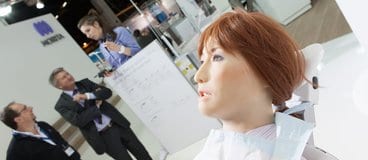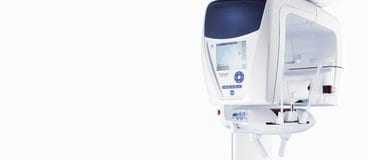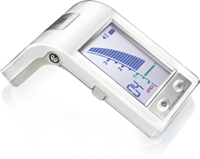The gentle revolution in dentistry: Root ZX II with Optimum Torque Reverse function combines the advantages of both rotating and cyclical-reciprocating technologies: as long as the adjusted torque value is not exceeded, the motor rotates permanently and, hence, advances at an optimal rate. As soon as the pressure on the file during the 180° rotation permanently exceeds the set value, the Torque Reverse will be activated and the rotation of the file will be reversed by 90° to release the instrument. Then the file will rotate again in the cutting direction. In this way, the unit controls torque permanently and reacts with the correct rotational direction in each case.
The worldwide success story of Morita started in the year 1916 when Junichi Morita founded the "Morita Shika Shoten" in Nakagyo Ward, Kyoto in Japan. This was based on the desire to improve not only the quality of life of patients, but also the quality of work of doctors and dentists. After just a few years, he decided to change the business from just importing medical devices to also include the development of products. Above all, it was his consistent endeavor for precision and uncompromising quality that motivated him to take this courageous step. This passion has repeatedly generated groundbreaking innovations in the course of the company’s history – and even today it continues to characterize our family-owned and family-managed enterprise.
-
-
2013

She talks, moves and looks like a human being: At the International Dental Show 2013, Morita presents the astonishingly „life-like“ robot patient SIMROID. Advanced technology has provided her with an “inner life”, enabling her to feel pain and communicate this to the practitioner. SIMROID is part of a new, interactive training program for dental students. This program simulates most in-practice situations and trains the specialist knowledge and communication skills of future dentists. Because everyone – whether robot or real human being – needs to feel themselves in good and understanding hands when they pay a visit to the dentist.
-
2013
-
-
2012

The combined system for panorama, cephalometric, and 3D imaging, the Veraviewepocs 3D R100, is equipped with an innovative image-registration function in the form of a so-called “Reuleaux triangle” which, by adapting itself to the natural arch of the teeth, excludes the areas lying outside of the examination area and secures an image of the dental arch in a way that minimizes exposure to radiation and is gentle on the patient. This new field of view has already won the Clinical Innovations Award in Great Britain as a “technological breakthrough”: It guarantees the precision of the images while at the same time reducing the dose of radiation that the patient is exposed to by almost 15 percent.
-
2012
-
-
2009
![]()
Morita introduces “Veraviewepocs 3De”, a multi-functional x-ray unit with two 3D fields of view. In addition, the company also introduces the “Air Torx” air motor and the “Root ZX mini”. An outstanding feature of “Air Torx” is its powerful torque. The “Root ZX mini” is the “compact” version of the famed “Root ZX” which was launched in 1991.

-
2009
-
-
2007
![Veraview-3D]()
With its new “Veraviewepocs3D”, Morita takes the art of manufacturing innovative and high-quality x-ray devices another step further. Worldwide, this is the first 2D/3D combination unit with “Panoramascout”. Morita also holds the patent for Panoramascout. This guarantees automatic and exact positioning in order to produce a 3D image.
-
2007
-
-
2004
![]()
Morita wins the race against time with its panorama x-ray unit “Veraview IC 5”: With an orbit time of only 5.5 seconds, the unit provides not only digital images but also brilliant resolution. This makes it the fastest orthopantomograph worldwide.
-
2004
-
-
2001
![]()
Morita introduces the “3D Accuitomo” at the International Dental Show. With this cone beam computed tomography unit, Morita has once again produced a pioneering performance as it is one of the first 3D units in the dental sector worldwide. Morita manages to provide the best quality of images in the x-ray sector in three dimensions as well.
-
2001
-
-
2000
The “TwinPower” turbine is a continuation of high-performance high-speed turbines. It has an impressive ergonomic design and is particularly user friendly. Its main features are: low weight, high torque (up to 370,000 rpm) and maximum output. Its unique anti-suck-back mechanism prevents bacteria from getting into the turbine. With this, it is setting the highest possible standard for hygiene.
-
2000
-
-
1997
![]()
With the “Veraviewepocs”, Morita introduces a new generation of x-ray units with autofocus for easy and exact patient positioning, automatic exposure and faster orbit times. This reduces radiation exposure for patients and prevents movement artifacts.
-
1997
-
-
1991
![]()
The “Root ZX” represents a major milestone in the history of endodontics. This is the first apex locator worldwide with impedance measurement which is not influenced by fluids. Morita registers the patent for this innovation. It has a significant influence on the endodontics sector and leads to easier and safer handling for the user. This is followed in 2002 by the “DentaPort ZX” which does not only measure the root canal but also enables preparation thanks to its integrated motor.
-
1991
-
-
1979
![]()
Morita optimizes the “PANEX-E” and presents its successor: the “Veraview”. A particular feature of this panorama x-ray device is its much higher imaging quality which is the result of a new-style electronic control system.
-
1979
-
-
1967
![]()
The first panorama x-ray device, the “PANEX-E” by Morita, depicts the complete jawbone while at the same time enormously reducing radiation exposure. The panorama x-ray devices simplify x-raying for both dentists and patients. Until now, it was only possible to x-ray the complete jawbone in individual parts, representing an extremely high radiation exposure for patients.
-
1967
-
-
1964
![]()
As a pioneer, Morita creates a completely new treatment unit. For the first time, dentists can sit in the so-called “twelve o’clock position” and treat patients who are lying down. Mr. Morita had the idea when heard about the back problems of the American dentist Dr. Daryl Beach. It was obvious to Morita that precision work could be best achieved with the body in a natural position. Consequently, the “Spaceline” unit revolutionized dental treatment.
-
1964
-
-
1959
![]()
The micro motors experience competition from high-speed turbines: They supplement the motors with their performance characteristics. Morita is one of the first manufacturers to introduce the celebrated high-speed turbines onto the market. The “Airjet” sets new standards because of its particularly fast operation enabling dentists to treat their patients without causing any great discomfort.
-
1959














